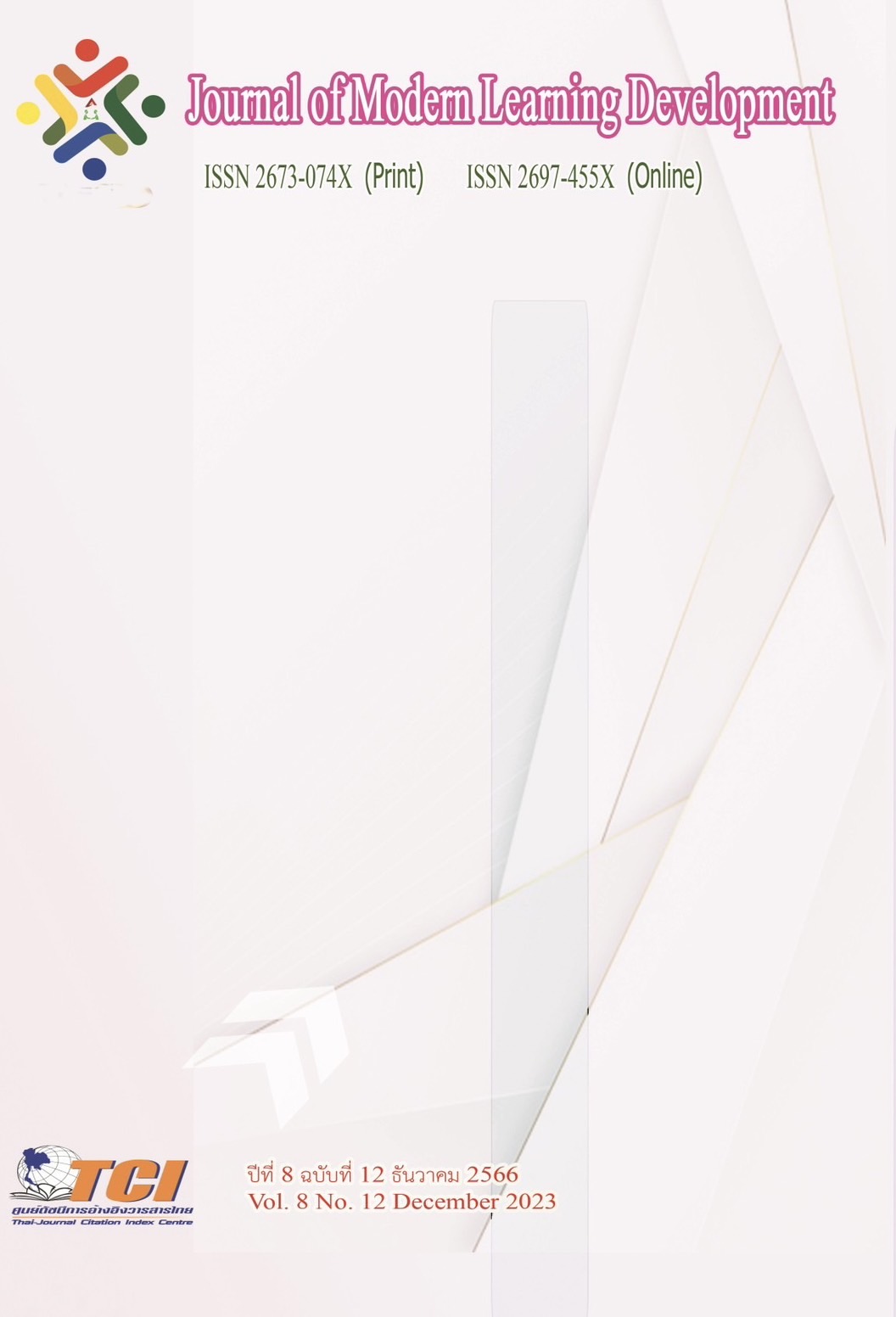นวัตกรรมการแปรรูปสับปะรดอบแห่งด้วยโรงอบแห่งสับปะรดโดยใช่พลังงานแสงอาทิตย์ร่วมสำหรับเกษตรกร ตำบลซับสีทอง อำเภอเมือง จังหวัดชัยภูมิ
Main Article Content
บทคัดย่อ
การวิจัยครั้งนี้มีวัตถุประสงค์ เพื่อ 1) ศึกษากรรมวิธีการแปรรูปสับปะรดอบแห้งด้วยโรงอบแห้ง สับปะรด โดยใช้พลังงานแสงอาทิตย์ร่วม สำหรับเกษตรกร 2) ออกแบบและสร้างโรงอบแห้งสับปะรด โดยใช้พลังงานแสงอาทิตย์ร่วม 3) ฝึกอบรมและพัฒนากระบวนการแปรรูปสับปะรดอบแห้งด้วยโรงอบแห้ง สับปะรดโดยใช้พลังงานแสงอาทิตย์ร่วม สำหรับเกษตรกร และ 4) ถ่ายทอดความรู้และเทคโนโลยีการแปรรูปสับปะรดอบแห้งด้วยโรงอบแห้งสับปะรดโดยใช้พลังงานแสงอาทิตย์ร่วม สำหรับเกษตรกร โดยมีกลุ่ม เป้าหมาย ได้แก่ เกษตรกรกลุ่มแปรรูปผลิตภัณฑ์สับปะรดอบแห้งด้วยโรงอบ แห้งสับปะรด โดยใช้พลังงานแสงอาทิตย์ร่วม ตำบลซับสีทอง อำเภอเมือง จังหวัดชัยภูมิ จำนวน 150 ราย ซึ่งได้มาด้วยวิธีการเลือกแบบเจาะจง (purposive Sampling) จากเกษตรกรที่สมัครเข้าร่วมโครงการวิจัย เครื่องมือที่ใช้การวิจัย ได้แก่ 1) แบบสัมภาษณ์แบบกึ่งโครงสร้าง 2) การศึกษาดูงาน 3) แบบสรุปข้อมูล ตารางสรุปแผนผังการออกแบบโครงสร้างโรงอบแห้งสับปะรด 4) การอบรมเชิงปฏิบัติการ 5) เอกสารประกอบการฝึกอบรม เรื่อง การแปรรูปสับปะรดอบแห้งด้วยโรงอบแห้ง สับปะรด โดยใช้พลังงานแสงอาทิตย์ร่วม 6) แบบประเมินความพึงพอ ใจของเกษตรกรกลุ่มแปรรูปผลิตภัณฑ์ที่มีต่อการอบรมเชิงปฏิบัติการ การวิเคราะห์ข้อมูล โดยใช้สถิติขั้นพื้นฐาน ค่าเฉลี่ย ส่วนเบี่ยงเบนมาตรฐาน และการวิเคราะห์เนื้อหา (Content Analysis)
ผลการวิจัย พบว่า
1. การทำสับปะรอบแห้ง โดยทั่วไปจะใช้วิธีการตากแห้งอาศัยแสงอาทิตย์ ให้ความร้อนเพื่อทำให้น้ำระเหยออกมา และให้ลมพัดเอาไอน้ำออกไป ทำให้อาหารได้รับสิ่งปนเปื้อนได้ง่าย จึงจำเป็นต้องอบแห้งในเครื่องอบหรือโรงเรือนอบแห้งด้วยพลังงานต่างๆ การศึกษาการแปรรูปสับปะรดที่เหมาะสมการพัฒนาสูตรและกรรมวิธีการการแปรรูปสับปะรดอบแห้งด้วยโรงอบแห้งสับปะรด โดยใช้พลังงานแสงอาทิตย์ร่วม โดยใช้เทคโนโลยีระดับชุมชน เพื่อให้ได้ผลิตภัณฑ์มีคุณภาพมาตรฐาน การพัฒนาสูตรและกรรมวิธีการแปรรูปสับปะรดอบแห้งด้วยโรงอบแห้งสับปะรด โดยใช้พลังงานแสงอาทิตย์ร่วม ซึ่งจากการศึกษาเอกสารและงานวิจัย วิเคราะห์กรอบแนวคิดเกี่ยวกับการแปรรูปสับปะรดอบแห้งด้วยโรงอบแห้งสับปะรด โดยใช้พลังงานแสงอาทิตย์ร่วม โดยใช้เทคโนโลยีระดับชุมชนเพื่อให้ได้ผลิตภัณฑ์มีคุณภาพมาตรฐาน การพัฒนากรรมวิธีการแปรรูปสับปะรดอบแห้งด้วยโรงอบแห้ง สับปะรด โดยใช้พลังงานแสงอาทิตย์ร่วม
2. คณะผู้วิจัยได้ทําการออกแบบและติดตั้งระบบเซลล์แสงอาทิตย์เพื่อให้การกระบวนการอบทําได้อย่างต่อเนื่องทั้งกลางวัน และกลางคืน ผลการทดสอบการใช้งานโรงอบแห้งสับปะรดโดยใช้พลังงานเซลล์แสงอาทิตย์ร่วม และผลการตรวจสอบระยะเวลาในการอบแห้งพบว่าเวลาในการอบแห้งหลังการปรับปรุง เหลือเพียง 36 ชั่วโมงและอุณหภูมิสูงสุดอยู่ที่ 70–80 องศาเซลเซียส ดังนั้น โรงเรือนอบแห้งพลังงานร่วมด้วยรังสีแสงอาทิตย์และไฟฟ้า สามารถนําไปใช้ในการอบแห้งผลผลิตทางการเกษตรเพื่อช่วยเกษตรกรในการอบแห้งและเพิ่มมูลค่าของผลผลิตสับปะรดอบแห้งได้ดี
3. ผลการฝึกอบรมและพัฒนากระบวนการแปรรูปสับปะรดอบแห้งด้วยโรงอบแห้งสับปะรดโดยใช้พลังงานแสงอาทิตย์ร่วม สำหรับเกษตรกร ตำบลซับสีทอง อำเภอเมือง จังหวัดชัยภูมิ เกษตรกรที่เข้ารับการอบรมผู้เข้ารับการอบรมมีความพึงพอใจอยู่ในระดับมาก มีค่าเฉลี่ยเท่ากับ 4.12
4. ผลการอบรมเชิงปฏิบัติการถ่ายทอดเทคโนโลยีการถ่ายทอดความรู้และเทคโนโลยีการแปรรูปสับปะรดอบแห้งด้วยโรงอบแห้งสับปะรด โดยใช้พลังงานแสงอาทิตย์ร่วม สำหรับเกษตรกร ตำบลซับสีทอง อำเภอเมือง จังหวัดชัยภูมิ ผู้เข้าร่วมการฝึกอบรมมีความพึงพอใจที่ได้รับความรู้เพิ่มขึ้นและมีความคาดหวังว่าจะสามารถนำความรู้ที่ได้ไปใช้ปฏิบัติจริงต่อไป ผู้เข้าร่วมสัมมนามีความพึงพอใจเกี่ยวกับการอบรมเชิงปฏิบัติการเรื่อง “การถ่ายทอดความรู้และเทคโนโลยีการแปรรูปสับปะรดอบแห้งด้วยโรงอบแห้งสับปะรดโดยใช้พลังงานแสงอาทิตย์ร่วม เฉลี่ยในทุกประเด็นอยู่ในระดับมาก (4.38)
Article Details
เอกสารอ้างอิง
จักรมาส เลาหวณิช และ สุพรรณ ยั่งยืน. (2553). การเปรียบเทียบความชื้นและอุณหภูมิของเมล็ดขาวโพด
ระหวางการอบแหงดวยอินฟราเรดและลมรอน. วารสารวิทยาศาสตรเกษตร. 41 (3/1 พิเศษ), 185-188.
จรัญ คนแรง และ อัญชณา อุประกูล.(2557). การพัฒนาตู้อบแห้งและการรมควันกำมะถันผักตบชวา
สำหรับ ชุมชนบ้านสาง ตำบลบ้านสาง อำเภอเมือง จังหวัดพะเยา. วารสารการพัฒนาชุมชนและ
คุณภาพชีวิต. 1, 3 (ก.ค. 2018), 233–242.
ชาลีดา บรมพิชัยชาติกุล. (2554). เทคโนโลยีการทำแห้งแบบผสมผสาน :การนำมาใช้เพื่อถนอมผลิตภัณฑ์
อาหารที่ไวต่อความร้อน. วารสารวิจัยและพัฒนา มจธ. ปีที่ 35 ฉบับที่ 2 เมษายน - มิถุนายน 2555.
บุญชม ศรีสะอาด. (2543). การวิจัยเบื้องต้น. (พิมพ์ครั้งที่ 7). กรุงเทพมหานคร: สุวีริยาสาส์น.
พิสิษฏ์ มณีโชติ และคณะ. (2552). เรื่องการพัฒนาและเผยแพร่เทคโนโลยีเครื่องอบแห้งพลังงานอาทิตย์
ร่วมกับพลังงานความร้อนจากชีวมวลเพื่อการแปรรูปผลิตผลทางการเกษตร. สำนักงานคณะกรรมการอุดมศึกษา. มหาวิทยาลัยนเรศวร.
ทนงศักดิ์ วัฒนา. (2554). เรื่องตู้อบกระเทียมพลังงานแสงอาทิตย์ร่วมกับก๊าซชีวมวล. ไทยแลนด์อินดัสตรี้ดอทคอม ,2554.
ธีรเดช ใหญ่บก. (2553). การพัฒนากระบวนการอบแห้งปลาด้วยเครื่องอบแห้งพลังงานร่วมแสงอาทิตย์-
ไฟฟ้าภายใต้สภาพภูมิอากาศภาคใต้ของประเทศไทย.วารสารมหาวิทยาลัยทักษิณปีที่ 12 ฉบับที่ 3
ตุลาคม 2552 - มกราคม 2553.
สำนักงานพัฒนาพลังงานแสงอาทิตย์. (2554). คู่มือเครื่องอบแห้งพลังงานแสงอาทิตย์. กรมพัฒนา
พลังงานทดแทน และอนุรักษ์พลังงานกระทรวงพลังงาน ร่วมกับภาคฟิสิกส์ คณะวิทยาศาสตร์มหาวิทยาลัยศิลปกร.
หริรักษ์ ควรประดิษฐ์. (2556). การพัฒนาเครื่องอบแห้งพลังงานรังสีอาทิตย์แบบจานรวมรังสีในกระบวนการอบแห้งผลิตภัณฑ์ทางการเกษตร. วารสารวิชาการอุตสาหกรรมศึกษา ปีที่ 7 ฉบับที่ 2 (กรกฎาคม - ธันวาคม 2556)
อนุสรา นาดี ยุทธนา ฏิระวณิชย์กุล และสุภวรรณ ฏิระวณิชย์กุล. (2555). จลนพลศาสตร์การอบแห้ง
ใบเตยด้วยรังสีอินฟราเรดร่วมกับลมร้อนและลมร้อนวารสารวิทยาศาสตร์บูรพา Vol. 17 No. 1
(2555).
Hudakorn, T. (2009). A study on performance of aV-groove flat plate solar collector for a solar dryer.In the 23th Conference of the MechanicalEngineering Network of Thailand, Chiang Mai,Thailand.
Jareanjit, J., Dusamoh, Y., Detsopha, S., & Chuyin,S. (2012). A solar dryer & moisture condensingcabinet with thermosyphon heat flow. KKUEngineering Journal, 38(1), 35-42.
Ketcharean, S. (2005). The Production Technologyof Fresh Pineapple Consumption of Farmers. N.P.:Department of Agricultural Extension.
Ninchuewong, T., Ekphon, A., Tirawanichakul, S.,& Tirawanichakul, Y. (2012). Drying of air driedsheet rubber using hot air dryer and solar dryer forsmall entrepreneurs and small rubber cooperatives.Burapha Science Journal, 17(2), 50-59.
Surbkar, R. (2013). Dehydration Technology. TheJournal of King Mongkut's University of TechnologyNorth Bangkok, 23(2), 500-512.
Taikhao, A., & Teekasap, S. (2013). Natura lConvection and Forced Convection Solar Dryers .EAU Heritage Journal, 7(1), 23-31.


